Five modules take on Atmel ARM9 chips
Dec 1, 2011 — by Eric Brown — from the LinuxDevices Archive — 7 viewsRonetix announced five computer on modules (COMs) whose ARM926-based Atmel AT91SAM9 supports Android, Linux, and Windows CE. The I/O for the five SAM9-CM modules varies slightly depending on which of the AT91SAM9G15/G25/G35/X25/X35 processors is incorporated, but all offer 400MHz performance, 128MB or 256MB of DDR2 SDRAM, 256MB of NAND flash, and 4MB or 8MB of SPI flash, says the company.
The Ronetix SAM9-CM supports a variety of embedded and industrial applications running Android, Linux, or Windows CE, says Ronetix. The 2.64 x 1.38-inch (67 x 35mm) module appears to be quite similar to the Ronetix PM9G45, which was announced by Ronetix in October along with a SK-PM9G45 starter kit. The difference is that it is available with five recent variations on the SAM9G45 processor featured in the earlier design — the SAM9G15, SAM9G25, SAM9G35, SAM9X25, and SAM9X35.
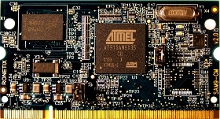
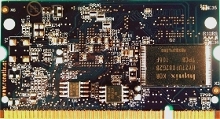
Ronetix SAM9-CM, front (left) and back
(Click on either to enlarge)
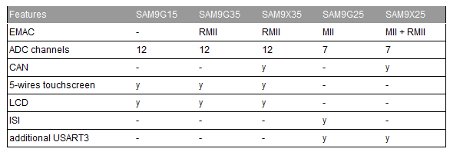
Feature comparison for the SAM9G15, SAM9G25, SAM9G35, SAM9X25, or SAM9X35
(Click to enlarge)
In addition to the I/O differences noted in the Ronetix-supplied table above, there are some other variations described in Atmel's detailed comparison chart of the five SAM9-CM processors. These variations include the lack of camera support on the SAM9G35 (block diagram).
The SAM9X25 and SAM9X35 processors, meanwhile, offer further iterations on the basic 400MHz ARM9 foundation, including CAN, ISI, and additional UARTs. Major differences between these two devices include a second Ethernet controller on the SAM9X25, and a second CAN interface and an LCD interface on the SAM9X35. More details can be found in our previous coverage and Atmel's SAM9X25 and SAM9X35 page.
All five SAM9-CM modules share an identical PCB and BGA217 socket, says Ronetix. The module configuration is stored in the DS2431 EEPROM, which can be accessed by the system through the OneWire Bus, says the company. The modules are said to support functions including graphics, audio, mass storage, networking, and multiple serial and USB ports.
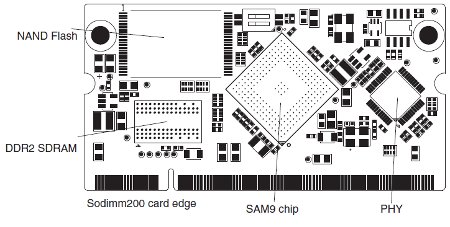
SAM9-CM diagram
(Click to enlarge)
- Processor — AT91SAM9G15/G25/G35/X25/X35 (217-ball LFBGA package) with 400MHz ARM926EJ-STM core
- Memory:
- 128MB or 256MB DDR2 SDRAM
- 256MB NAND flash
- 4MB or 8MB Atmel SPI flash
- Networking — 10/100 Ethernet controller
- Other I/O:
- n/s
- Dimensions — 2.64 x 1.38 inches (67 x 35mm)
- Operating temperature — 32 to 158 deg. F (0 to 70 deg. C); extended temperature versions -40 to 185 deg. F (-40 to 85 deg. C)
Like the earlier Ronetix PM9G45 module, the SAM9-CM modules are available with a starter kit, as well as the Ronetix PEEDI debugger. This time, however, instead of providing a Ronetix-branded device, the company links to an Atmel page offering different kits depending on the processor.
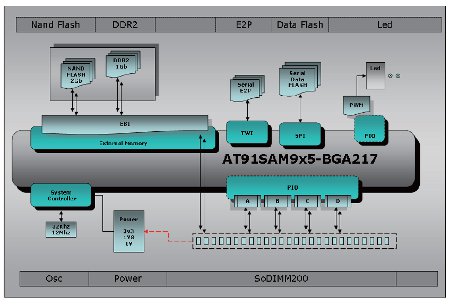
SAM9-CM block diagram
(Click to enlarge)
Availability
The Ronetix SAM9-CM modules are available now, with a choice of Atmel SAM9G15, SAM9G25, SAM9G35, SAM9X25, or SAM9X35 processors. More information may be found at this Ronetix SAM9-CM product page.
More information on the SAM9-CM starter kits may be found in this Atmel starter kit page, as well as this SAM9-CM starter kit data sheet [PDF].
This article was originally published on LinuxDevices.com and has been donated to the open source community by QuinStreet Inc. Please visit LinuxToday.com for up-to-date news and articles about Linux and open source.